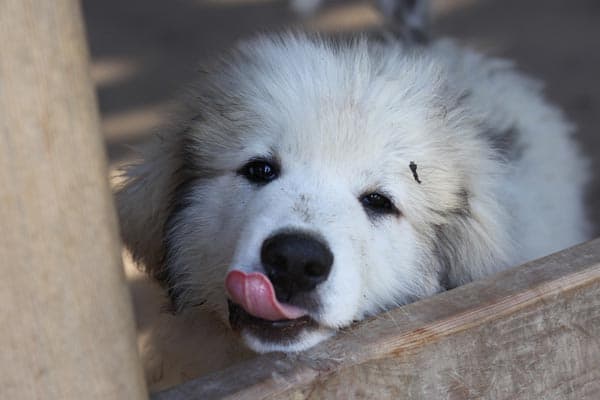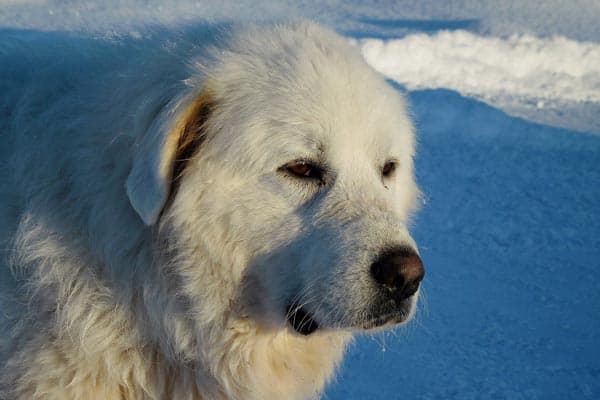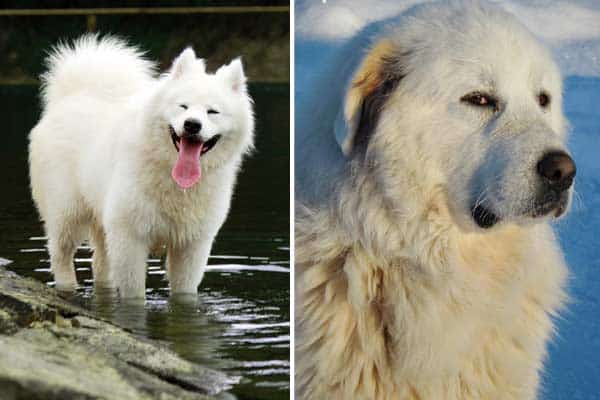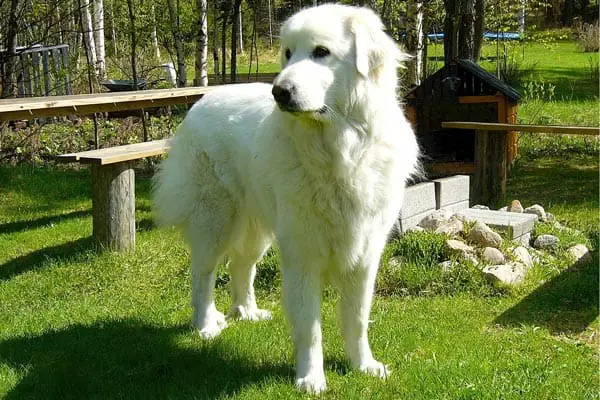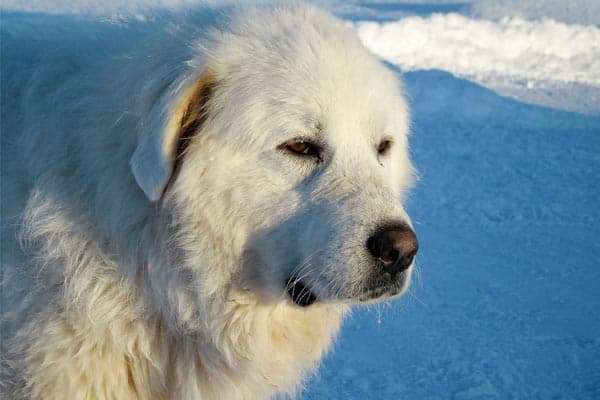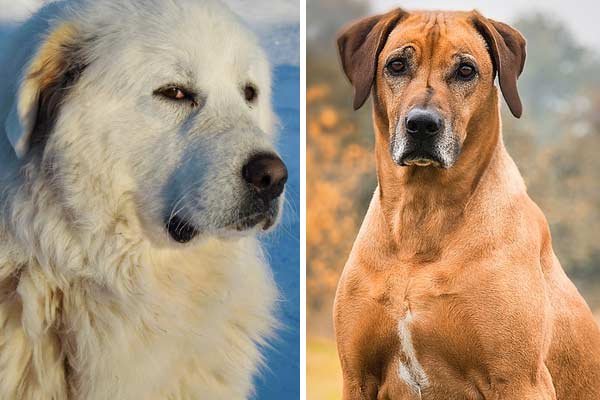Why Is the Great Pyrenees Bite Force Stronger than Expected?
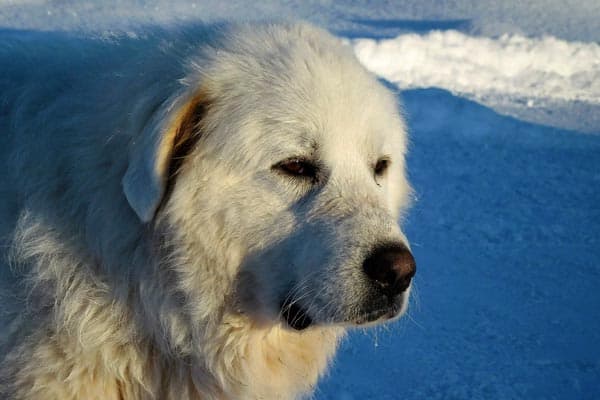
How do you think the Great Pyrenees compares in strength to other breeds? When measuring Great Pyrenees bite force, where do you think it would fall within the dog kingdom?
If you guessed the Pyr would run in the middle of the pack in a breed contest of power, you would be close. It would be more accurate to say the Great Pyrenees is near the top among its counterparts.
The great Pyrenees bite force is about 500 to 650 PSI, putting it on par with members of the Mastiff family and a few livestock guardian dogs. A dog’s body mass, jaw muscles, and head structure determine bite force.
However, the Great Pyrenees, at 100-plus pounds, is strong beyond its jaws. Its wedge-shaped head and relatively long jawline give it the leverage it needs to bite with incredible pressure.
How do you define and measure bite force?
When you define bite force, it is easy to understand because it is exactly as it sounds.
Bite force or pressure is expressed in PSI or pounds of force per square inch. Since experts typically measure pressure in Newtons, you might wonder why canine experts convert these numbers into PSI for their lists of strong bite forces.
Stopbsl.org expresses doubts that you can even measure an animal’s bite force accurately through any means other than Newtons or pound-force. However, PSI conversions put the numbers in a format that people can better understand.
The problem comes when laypeople make uninformed calculations or assume Newtons and PSI are the same. It has led to gross exaggerations of the bite force of dogs already struggling with bad publicity.
A Newton is only a fifth of a pound, debunking claims that certain breeds could bite with 2,000 pounds of pressure.
Complicating Factors of Bite Force
Several factors make bite force difficult to assess accurately.
When you see a source with different bite forces of some of the strongest dogs, they are referring to the tooth pressure when a canid clamps its jaws.
It is subtle semantics, but some teeth crush while others pierce. The former group has higher bite pressure over a larger surface area, while the latter involves more pinpoint force or penetration.
Such differences are not relevant when comparing dog breeds but become more important when crossing over to big cats.
The distinction is also pertinent when trying to ascertain which species was responsible for a bite during the investigation of an injury or crime.
Additional difficulties that can arise when trying to measure bite force or pressure are as follows:
- You cannot successfully direct a dog to bite as hard as she can or chew on command; scientists have had some success with transducer implants
- Dogs bite variably – Intent (defensive or attack), breed selection (picture “soft mouth” of Labrador Retriever or Cocker Spaniel), and motivation (warning or full-blown attack) play a role
- Electrostimulation used to help measure jaw strength and bite force in anesthetized dogs is not entirely accurate
- Disease adversely affects bite force – Malocclusion of teeth, dysfunction of the temporomandibular joint, and jaw or mouth pain.
According to Frontiers in Veterinary Medicine, there are a couple of promising methods to determine a dog breed’s bite force with excellent accuracy.
One involves estimates of the masseter and temporomandibular measurements by assessing the areas on the skull where the muscles attach. Together with body mass and an estimation of how much leverage the dog can gain with its mandible, scientists can perform a three-dimensional analysis of the forces involved in a bite.
Another method looks at estimations through computer tomography models.
The bite force is typically the mean between how hard a dog snaps her canines down at the front of her mouth and at the focal point where the jaws meet. In a large dog, the difference between these two measurements can be as high as 400 PSI.
For example, a Rottweiler that has 225 PSI of power when she nips you with her incisors may have a bite force of 650 PSI towards the back of her mouth. If you average the two, you get an overall bite pressure of 437.5 PSI.
Relevance of Bite Force
A dog’s bite force has more importance than satisfying our insatiable curiosity and desire to make comparisons.
Bite force may play a role in forensics when investigators try to determine if a particular dog was involved in a bite. Even in justified attacks, it is useful to be able to pinpoint or rule out certain dogs.
Intercanine spacing in bite force estimates hopefully will make it easier to identify breeds involved in bites. Bite pressure is also relevant from the standpoint of managing tissue damage.
Several statistics put the Great Pyrenees’ bite force into perspective.
Humans have an average bite force of 120 to 150 PSI, according to Science Focus. Toy dogs have bite forces anywhere from 90 PSI to 170 PSI. It takes over 1400 Newtons, or about 285 PSI, to fracture your finger. The largest bone in your leg, the femur, requires about 800 PSI, according to Discovery.com.
However, the force required to achieve that same level in a young child or elderly person is much lower.
Where strong dogs are exact, the most punishing damage is a crushing injury to soft tissues. Dogs that attack often grip and shake whatever they bite, which causes tearing as well as bruising. Another leading cause of morbidity is infection from punctured wounds.
Fatalities do not occur from broken bones but rather from a dog’s attacking the face, head, and neck. These areas are much more vulnerable to the biting ranges of most large dogs, which is between 200 and 300 PSI.
A dog intent on causing bodily harm, which is rare, bites people on the lower limbs to bring them to the ground. They attack other dogs in this manner also if they cannot readily access the throat.
Small children are already at face level with most large dogs, making them vulnerable to serious attacks.
They also succumb much more easily to a strong bite force from such a dog as the Great Pyrenees than an adult would.
Luckily, Great Pyrenees are usually gentle with young kids, but the breed’s strength emphasizes the importance of always supervising kids in the presence of dogs.
How should you categorize the Great Pyrenees?
You may already know that the Great Pyrenees is a livestock guardian dog. LGDs differ from herding dogs in a few crucial ways.
- LGD lives among its flock or herd as a non-threatening member; herding dogs ply their trades through a honed predatory instinct
- It is much more acceptable, sometimes preferable, for an LGD to be white; herding dogs are usually darker in color and thought to be more intimidating to livestock.
- Early herders wanted to distinguish LGDs from predators and herding dogs from sheep.
- LGDs guard flocks from predators and herding dogs move the flocks with sometimes a secondary job of warding off predators and human thieves; in historical times, herders may have had both working at the same time.
In keeping with their separate roles, livestock guardian dogs tend to be larger and stronger than herding dogs. They bond more closely with the animals in their charge and have a more formidable bite force.
LGDS need a stronger grip in their jaws to confront and attack predators if necessary.
Although many LGDs are fleet, herding dogs are typically quicker and more agile. Some of it is their smaller build, but much of it is the necessity for them to move their flocks or herds without seriously harming any of their charges.
In a guard capacity, a Great Pyrenees can bite harder than most appointed guard dogs like the Rottweiler, GSD, or Doberman.
However, with such high guarding instincts, any of the guard dogs may be more motivated and thus apply more biting pressure in many situations.
How does the Great Pyrenees bite force compare to other breeds?
Sources estimate the Great Pyrenees bite force to lie between 500 PSI and 700 PSI, putting it in the upper middle of the top ten strongest dogs.
You hardly ever see the Pyr on any lists for bite force because it is not infamous through the news, nor is it a typical guard dog.
The Great Pyrenees is also not popular except in circles that still value it for its original intent. Therefore, we had to place the breed where the numbers fit.
Some lists exclude the Kangal, presumably because it is not an AKC breed. Others do not list the Cane Corso or place the Belgian Malinois ahead of the German Shepherd.
It shows you that bite force in dogs is still a misunderstood science and thus still subject to people’s biases and favoritism. Likewise, the following list is neither exact nor all-inclusive.
10. Akita
- Bite force – 350 to 400 PSI
- Country – Japan
- Purpose – Fighting, guarding, police, hunting
- Family – Spitz
- Size (American) – 100 to 130 pounds
- Head – Wedge-shaped
9. Leonberger
- Bite force – 399 PSI
- Country – Germany
- Purpose – Herding, pulling carts, companions, military
- Family – Bloodlines possibly from Newfoundland, Great Pyrenees, and St Bernard
- Size (American) – 90 to 170 pounds
- Head – Rectangular, deeper than broad, muzzle and skull equal lengths
8. Dogo Argentino
- Bite force – 500 PSI
- Country – Argentina
- Purpose – Hunt large game in packs
- Family – Mastiff
- Size – 77 to 100 pounds
- Head – Rectangular, deeper than broad, muzzle and skull equal lengths
7. Dogo Canario
- Bite force – 540 PSI
- Country – Spain
- Purpose – Herd cattle and sheep, dogfighting, guard dog
- Family – Mastiff
- Size – 80 to 130 pounds
- Head – Broad and deep head, muzzle a third length of skull
6. Mastiff
- Bite force – 550 PSI
- Country – England
- Purpose – Guard dogs, blood sports, hunting
- Family – Mastiff
- Size – 120 to 230 pounds
- Head – Massive head, muzzle a third length of skull
5. Dogue de Bordeaux
- Bite force – 550 to 560 PSI
- Country – France
- Purpose – Animal baiting, dogfighting, guard dog, herding
- Family – Mastiff
- Size – 120 to 140 pounds
- Head – Massive head relative to body, angular, muzzle short
4. Tosa Inu
- Bite force – 560 PSI
- Country – Japan
- Purpose – Dogfighting, guard dog
- Family – Mastiff
- Size – 80 to 200 pounds (Japanese dogs 130 pounds or less)
- Head – Broad and rectangular
3. Great Pyrenees
- Bite force – 520 to 700 PSI
- Country – France
- Purpose – Livestock guardian dog, companion, guard dog
- Family – LGD
- Size – 80 to 120 pounds
- Head – Wedge-shaped with gradual taper, as broad as long; muzzle and skull equal lengths
2. Cane Corso
- Bite force – 700 PSI
- Country – Italy
- Purpose – Light war dog, guard dog, herding
- Family – Mastiff
- Size – 80 to 120 pounds
- Head – Square-shaped, broad and deep
1. Kangal (includes Anatolian Shepherd)
- Bite force – 750 to 900 PSI
- Country – Turkey
- Purpose – Livestock Guardian Dog
- Family – LFG; sighthound and Mastiff
- Size – 90 to 150 pounds
- Head – Rectangular; muzzle, and skull same length
It is interesting when you compare the strength of some of the most notorious guard dogs with the canids with the top 10 biting pressures.
- German Shepherd – 238 PSI
- Doberman – 300 PSI
- Rottweiler – 350 PSI
The Pit Bull Terrier, the most dangerous dog in the United States at least, only has a bite force of about 230 PSI.
Dogs with the strongest bites are usually in the Mastiff family and have square or rectangular heads.
All of them have a width of head and jaw that supports powerful masseter and temporomandibular muscles. They also each have a large base body mass.
A wedge shape to the head may give the dog even more strength in his bite than you would ordinarily expect based on type, breed, or size.
Does Great Pyrenees bite force make them dangerous?
You have doubtless heard it time after time – any breed or every dog can be dangerous under the right circumstances.
However, you should be on notice and doubly cautious with a large protective dog with a bite force over 200 PSI.
A dog’s bite force is not what makes it dangerous. Pyrenean Mountain Dogs have a long history of working with sheep and other livestock, but they require years of training.
Without appropriate education, livestock guardian dogs can injure and even kill animals they were originally intended to guard with their lives.
Another scenario occurs when someone acquires a Great Pyrenees puppy to be a pet but fails to conscientiously socialize her.
This dog develops guarding instincts she has no idea how to deal with. She becomes shy, unsure, and timid or attacks without provocation.
In both cases of lack of socialization or an untrained LGD, your Great Pyrenees could mistake children as prey and chase them or worse.
One last thing to take away is that the Great Pyrenees is as dangerous as any working dog performing its duty in a protective capacity can be. You would never approach a police dog while he was performing his job.
Livestock guardians guard the animals under their care and will chase away any intruders and attack them if they do not move away fast enough. On duty, their targets would include children, people, and dogs, as well as predators.
While it is normal to leave the task of training Pyrenees puppies to the older and established generations of LGDs, it is your responsibility to socialize them with people.
Otherwise, you may have a dog that will not allow you to come near your livestock or may attack other livestock guardian dogs.
Examples
The Great Pyrenees has a large, although not massive, body size. You can see the head’s roughly rectangular shape in the profile. Looking down at the dog from above, you would be able to see the mild wedge.
Interestingly, the dog that walks in front of them is a Golden retriever, a breed with a notably soft mouth for retrieving. This is an appropriate response from the Great Pyrenees.
They recognize there is no threat but are issuing clear warnings anyway. Unsocialized dogs would react more dramatically and probably try to push past the fence.
You can see that the Kangal has a similar head to the Great Pyrenees. There is even the hint of a wedge when you look down on the Kangal from above.
Kangals purportedly have the strongest bite of domesticated dogs, with some sources giving them credit for a bite force of 900 PSI.
You will notice right away that these dogs do not have the massive block-shaped head of Mastiffs.
However, the Great Pyrenese and Kangal have a slightly triangular shape to their heads, similar to the wolf. Wolves in defensive mode can bite down with 1200 PSI, so there might be something powerful in a head’s wedge shape.
It likely provides additional support and strength for muscles that attach to the top of the head and the well-developed cheekbones.
